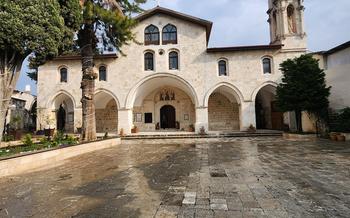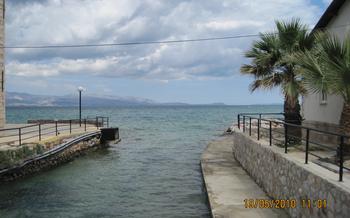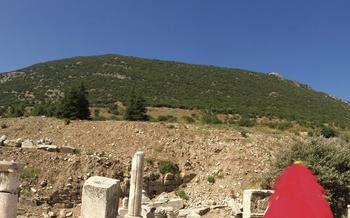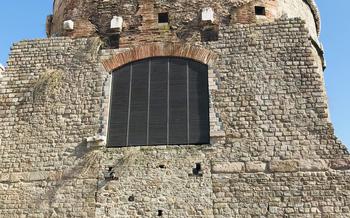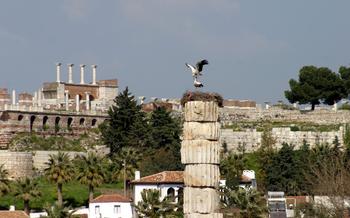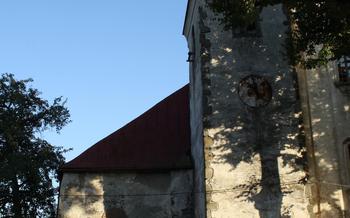
Çeşme Aya Haralambos Church
- Historical Significance of the Church
- Location and Accessibility
- Architectural Features
- Religious Significance:
- Cultural Importance:
- Interior Highlights
- Historical Events and Personalities
- Local Festivals and Celebrations:
- Pilgrimage Site for Orthodox Christians:
- Community Involvement:
- Restoration and Preservation Efforts:
- Photography and Videography Guidelines:
- Nearby Attractions and Activities:
- Insider Tip:
Historical Significance of the Church
The Çeşme Aya Haralambos Church, initially constructed in the 19th century, holds immense historical significance within the Çeşme region. It stands as a testament to the rich cultural heritage and religious diversity that has characterized the area throughout the ages. Originally built as a Greek Orthodox church, it served as the primary place of worship for the Greek Orthodox community of Çeşme during the Ottoman period. The church's resilience amidst various historical events, including the population exchange between Greece and Turkey in 1923, has made it a symbol of religious continuity and tolerance in the region. Today, the church stands as a reminder of the rich history and heritage that have shaped the cultural fabric of Çeşme.
Location and Accessibility
The Çeşme Aya Haralambos Church is conveniently situated in the heart of Çeşme, a charming coastal town in Turkey. Its exact address is Atatürk Bulvarı No:116, 35930 Çeşme/İzmir, making it easily accessible from various parts of the town.
To reach the church, you can take advantage of the well-connected public transportation system. Several bus lines, including the 811 and 812 buses, stop within a short walking distance from the church. Alternatively, if you prefer a more scenic journey, you can hop on a ferry from the nearby Çeşme Ferry Port and enjoy a picturesque ride across the sparkling waters.
For those arriving by car, there are ample parking options available in the vicinity of the church. You can conveniently park your vehicle in one of the designated parking lots or along the surrounding streets.
The Çeşme Aya Haralambos Church is committed to ensuring accessibility for all visitors, regardless of their physical abilities. The church features wheelchair-accessible ramps and designated seating areas, allowing individuals with disabilities to comfortably participate in religious services and explore the church's interior.
Architectural Features
The Çeşme Aya Haralambos Church boasts a striking architectural blend of Byzantine and Ottoman influences. Its exterior facade showcases intricate stone carvings, arched windows, and a grand entrance adorned with elaborate moldings. The interior reveals a spacious nave, supported by rows of elegant columns and topped by a magnificent dome. The dome's interior is adorned with stunning frescoes depicting biblical scenes and angelic figures.
The church's altar is a focal point, featuring an ornate iconostasis adorned with intricate carvings and gold leaf. The sanctuary is embellished with beautiful mosaics depicting religious figures and symbols. Notable features include the church's bell tower, which offers panoramic views of Çeşme, and the stained-glass windows that fill the interior with vibrant colors.
When compared to other similar churches in the region, the Çeşme Aya Haralambos Church stands out for its unique blend of architectural styles. Its Byzantine roots are evident in the use of domes, arches, and intricate mosaics, while the Ottoman influence is reflected in the intricate stone carvings and the grand entrance.
Religious Significance:
The Çeşme Aya Haralambos Church holds immense religious significance for the Orthodox Christian community in Çeşme and beyond. It is dedicated to Saint Haralambos, a revered saint in the Orthodox tradition, who is believed to have the power to heal diseases and protect against natural disasters. According to legend, Saint Haralambos was martyred during the reign of Emperor Septimius Severus after refusing to renounce his Christian faith. His relics are said to be housed in a monastery on Mount Athos in Greece, and his feast day is celebrated on February 10th. At the Çeşme Aya Haralambos Church, annual religious festivals and celebrations are held to honor Saint Haralambos, attracting a large number of pilgrims and worshippers. These festivals include processions, divine liturgies, and traditional dances, creating a vibrant atmosphere of devotion and community spirit.
Cultural Importance:
The Çeşme Aya Haralambos Church stands as a testament to the rich cultural heritage of Çeşme, showcasing a unique blend of Byzantine and Ottoman influences. The church's architecture, with its graceful domes and intricate stonework, reflects the Byzantine legacy, while the minaret, added during the Ottoman period, symbolizes the harmonious coexistence of different cultures and religions.
The church played a pivotal role in shaping the cultural landscape of Çeşme. It served as a center of religious worship for the local Orthodox Christian community and contributed to the town's cultural identity. Over the centuries, the church witnessed and influenced the development of local traditions and customs, becoming an integral part of the community's cultural fabric.
One of the most significant local traditions associated with the church is the annual celebration of Saint Haralambos' feast day on February 10th. This festival attracts pilgrims and visitors from across the region, who come to pay homage to the saint and participate in the festivities. The church becomes a hub of religious devotion, cultural expression, and community gathering, showcasing the vibrant cultural heritage of Çeşme.
Interior Highlights
The interior of the Çeşme Aya Haralambos Church is a testament to the rich artistic and religious heritage of the Orthodox Christian tradition. Exquisite iconography and frescoes adorn the walls and ceilings, depicting biblical scenes, saints, and religious figures with vibrant colors and intricate details. The ornate altar and sanctuary are the focal points of the church, featuring elaborate carvings, gold leaf embellishments, and a beautifully crafted iconostasis. Significant religious artifacts and relics are also housed within the church, including relics of Saint Haralambos himself, which are revered by pilgrims and visitors alike. In comparison to other notable church interiors, the Çeşme Aya Haralambos Church stands out for its harmonious blend of Byzantine and Ottoman influences, creating a unique and awe-inspiring space for worship and contemplation.
Historical Events and Personalities
The Çeşme Aya Haralambos Church has witnessed numerous historical events and is linked to several notable personalities. It is believed that the church was built on the site of an ancient temple dedicated to the Greek goddess Artemis, adding a layer of historical significance to its location. During the Byzantine era, the church was a prominent religious center and a symbol of the region's Christian heritage.
One of the most significant events associated with the church is its role during the Greek War of Independence. The church served as a refuge for Greek refugees fleeing persecution and violence. It is said that the church's bell tower was used as a lookout point to signal approaching Ottoman forces, helping the local population prepare for attacks.
Throughout its history, the church has been visited by numerous notable figures, including prominent religious leaders, scholars, and dignitaries. One of the most famous visitors was the renowned Greek Orthodox Patriarch of Constantinople, Ecumenical Patriarch Bartholomew I, who visited the church in 2010 and led a special service.
The church also holds a special place in the hearts of the local community. Many families have a deep connection to the church, with generations of baptisms, weddings, and funerals taking place within its walls. Over the years, the church has become a symbol of continuity and tradition, preserving the cultural and religious heritage of Çeşme.
Local Festivals and Celebrations:
The Çeşme Aya Haralambos Church is not only a place of worship but also a vibrant hub for cultural and religious festivities. Throughout the year, the church hosts several annual festivals and celebrations that draw both locals and visitors. One of the most significant events is the Feast of Saint Haralambos, the patron saint of the church, which takes place on February 10th. During this festival, the church is adorned with colorful decorations, and a special liturgy is held in honor of Saint Haralambos. Devotees from far and wide flock to the church to pay their respects and seek blessings.
Another notable celebration is Easter, which is observed with great solemnity at the Çeşme Aya Haralambos Church. During Holy Week, special services and processions are held, culminating in the joyous celebration of Easter Sunday. The church's interior is adorned with flowers and candles, creating a festive atmosphere. Locals and visitors alike gather to participate in these celebrations, sharing in the spirit of renewal and rebirth.
These festivals and celebrations are not just religious events but also vibrant expressions of the local culture and traditions. They provide a glimpse into the rich heritage of Çeşme and offer a unique opportunity for visitors to immerse themselves in the local way of life. Participating in these events is a wonderful way to connect with the community and experience the true essence of Çeşme.
Pilgrimage Site for Orthodox Christians:
The Çeşme Aya Haralambos Church holds a profound significance as a pilgrimage site for Orthodox Christians from around the world. For centuries, devout believers have undertaken pilgrimages to this sacred place, seeking spiritual guidance, blessings, and connection with their faith.
The church's reputation as a pilgrimage site stems from its association with Saint Haralambos, a revered martyr who is believed to have lived in the 3rd century AD. According to legend, Saint Haralambos was a priest who suffered persecution for his unwavering belief in Christianity. He is said to have performed numerous miracles during his lifetime, including healing the sick and raising the dead.
Orthodox Christians from across the region and beyond flock to the Çeşme Aya Haralambos Church to pay homage to Saint Haralambos and seek his intercession. Pilgrims often bring offerings of candles, flowers, and personal items to be blessed at the church. They participate in special religious services, light candles, and pray for guidance, healing, and protection.
The pilgrimage to the Çeşme Aya Haralambos Church is a deeply personal and transformative experience for many Orthodox Christians. It is an opportunity to strengthen their faith, connect with fellow believers, and receive spiritual renewal. The church's serene atmosphere, coupled with the stories of Saint Haralambos' miracles, creates a profound sense of peace and reverence among pilgrims.
Community Involvement:
The Çeşme Aya Haralambos Church is deeply embedded in the fabric of the local community. It serves as a spiritual and cultural hub, fostering a sense of unity and belonging among the residents. The church actively engages in social and charitable initiatives, extending its support to those in need. Community outreach programs and events are organized throughout the year, providing opportunities for members to connect, socialize, and contribute to their neighborhood. Visitors are welcome to participate in these activities, experiencing firsthand the warmth and hospitality of the local community. By volunteering or making a donation, visitors can contribute to the church's ongoing efforts and leave a positive impact on the community.
Restoration and Preservation Efforts:
The Çeşme Aya Haralambos Church has undergone several restoration projects throughout its history to maintain its architectural integrity and historical significance. In the early 20th century, the church underwent extensive renovations to repair damage caused by earthquakes and the passage of time. These renovations focused on reinforcing the structure, restoring the interior frescoes, and preserving the overall design.
In recent years, another major restoration project was undertaken to address the church's deteriorating condition. This project involved cleaning and repairing the exterior facade, restoring the interior iconography, and upgrading the electrical and plumbing systems. The restoration team worked closely with experts in Byzantine art and architecture to ensure that the church's original features were preserved.
The successful completion of these restoration efforts has ensured that the Çeşme Aya Haralambos Church remains a testament to the rich cultural heritage of Çeşme and a source of pride for the local community. The church's ongoing preservation is a testament to the importance of protecting and celebrating historical landmarks that contribute to the unique identity of a region.
Photography and Videography Guidelines:
When visiting the Çeşme Aya Haralambos Church, it is important to be respectful of the religious and cultural significance of the site. Photography and videography are generally allowed inside the church, but certain guidelines and etiquette must be followed.
-
Respect the Privacy of Others: Remember that the church is a place of worship, and visitors should be mindful of the privacy of other worshippers. Avoid taking photos or videos of individuals without their consent, especially during religious services or ceremonies.
-
No Flash Photography: Using flash photography inside the church is generally prohibited as it can be disruptive to worshippers and damage sensitive artwork or artifacts. Natural light or low-light photography is preferred.
-
Tripods and Selfie Sticks: The use of tripods and selfie sticks is typically not permitted inside the church due to safety concerns and to avoid obstructing other visitors. Handheld photography is generally preferred.
-
Respectful Angles and Compositions: When taking photos or videos, choose angles and compositions that are respectful of the church's sacred nature. Avoid capturing images that may be considered inappropriate or disrespectful to the religious significance of the site.
-
Silent Mode and Discretion: Keep your camera or phone on silent mode and be discreet when taking photos or videos. Avoid making loud noises or causing distractions during religious services or ceremonies.
-
Share with Care: If you share your photos or videos online, be mindful of the privacy of others and the church's intellectual property rights. Obtain permission before sharing images of individuals or sensitive artwork.
Nearby Attractions and Activities:
Beyond the spiritual and historical charm of the Çeşme Aya Haralambos Church, visitors can explore a wealth of other attractions in the vicinity. The Çeşme Castle, a majestic Ottoman-era fortress, stands as a testament to the region's rich past. With its imposing walls and panoramic views, the castle offers a captivating glimpse into the town's heritage.
For those seeking a taste of the local culture, the Çeşme Bazaar is a must-visit. This vibrant marketplace bustles with activity, offering an array of traditional Turkish handicrafts, souvenirs, and delectable treats. Visitors can haggle for unique textiles, ceramics, jewelry, and spices, immersing themselves in the lively atmosphere of this authentic Turkish bazaar.
After exploring the historical and cultural treasures, indulge in the culinary delights that Çeşme has to offer. The town boasts an array of restaurants and cafes, serving everything from traditional Turkish cuisine to international fare. Savor the flavors of fresh seafood, succulent kebabs, and aromatic mezes while enjoying the picturesque views of the Aegean Sea.
To further enhance your Çeşme experience, consider embarking on a boat tour. Set sail on the crystal-clear waters and discover hidden coves, secluded beaches, and stunning coastal landscapes. Take a refreshing dip in the sea, soak up the sun on a secluded beach, or simply relax on the boat while admiring the breathtaking scenery.
For those seeking a more active adventure, Çeşme offers plenty of opportunities for outdoor enthusiasts. Hike or bike along scenic trails, explore the surrounding countryside, or indulge in water sports such as windsurfing, kitesurfing, and diving. With its pristine beaches, clear waters, and favorable winds, Çeşme is a paradise for water sports enthusiasts.
Insider Tip:
-
For a unique experience, visit the church during the annual religious festivals, such as the Feast of Saint Haralambos on February 23rd. The church transforms into a vibrant hub of activity, with processions, traditional music, and local delicacies. Immerse yourself in the festive atmosphere and connect with the local community.
-
Discover the hidden gem of the church's courtyard, where a serene garden awaits. Take a moment to relax and reflect amidst the lush greenery and colorful flowers. It's the perfect spot to escape the hustle and bustle of the city and find inner peace.
-
If you're a photography enthusiast, capture the church's beauty during the golden hour, when the warm sunlight casts a magical glow on its exterior. The intricate details and vibrant colors of the facade come alive, creating stunning photo opportunities.
